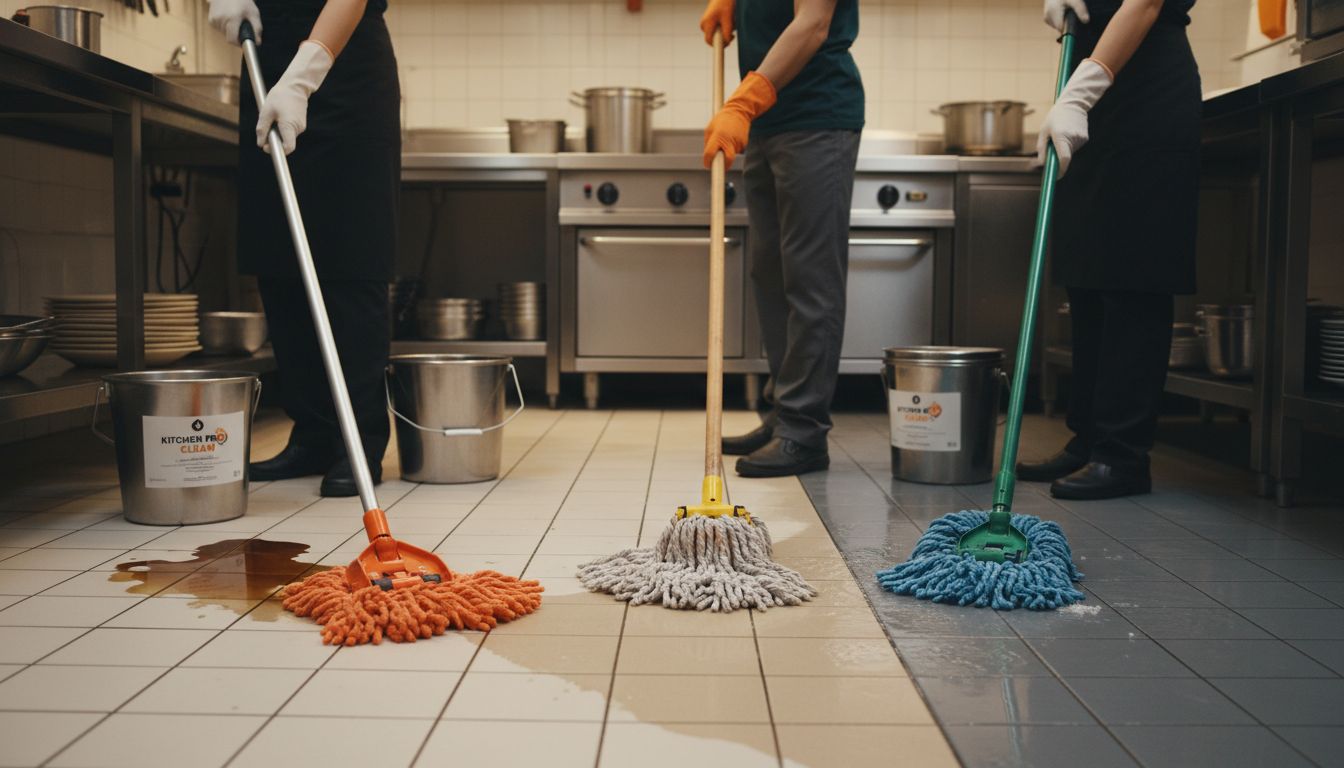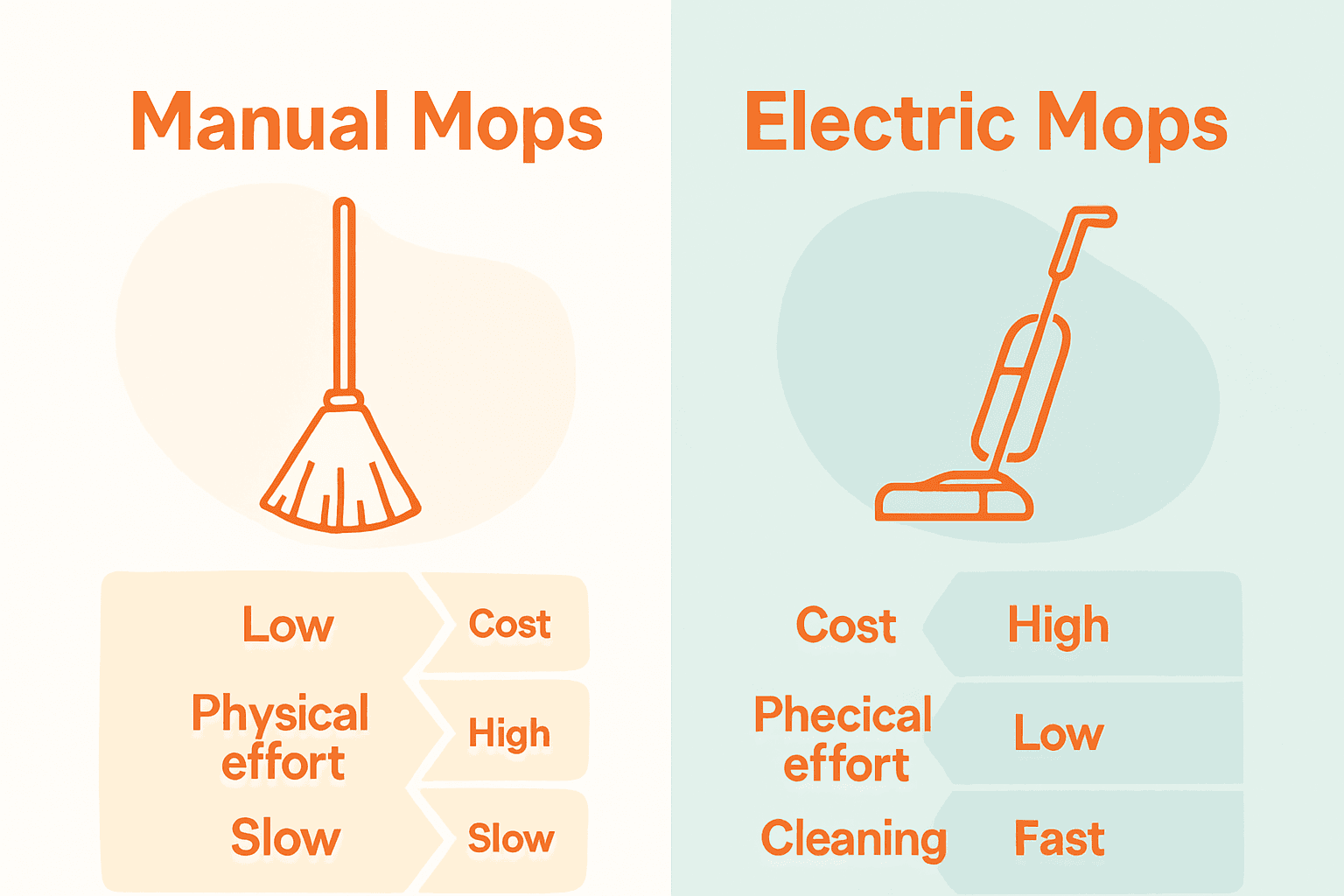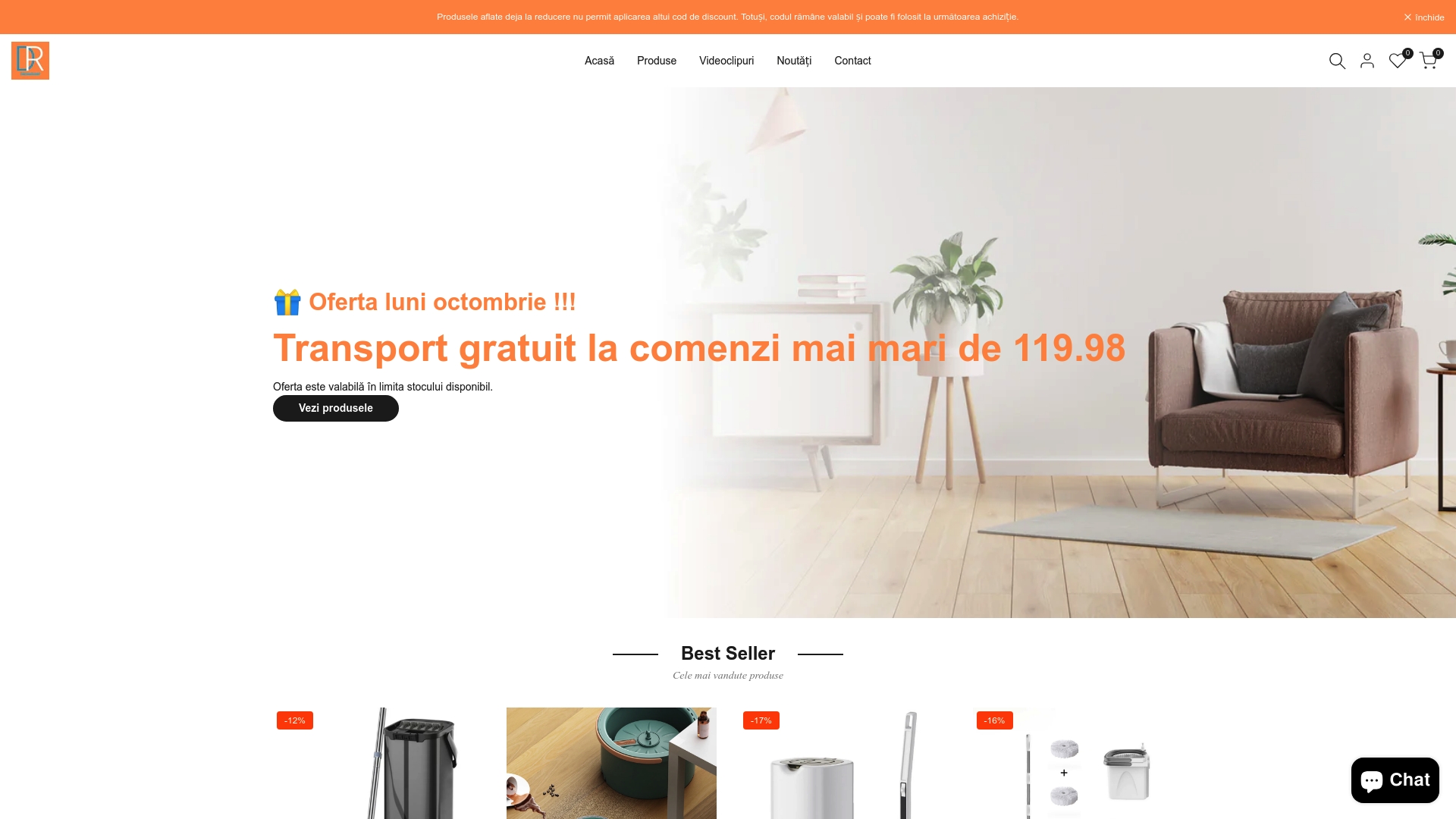Over 80 percent of homes still rely on mops for daily cleaning, proving these simple tools haven’t lost their value in a world crowded with gadgets. Whether you face stubborn kitchen spills or need to keep commercial spaces spotless, the right mop can make the job much easier and help protect your floors. By understanding the different types of mops and their specific strengths, you can choose the best option to keep your environment clean and hygienic.
Table of Contents
- Definition And Purpose Of Mop Types
- Manual Mops Versus Electric Mops Explained
- Key Features Of Different Mop Designs
- Selecting The Right Mop For Your Needs
- Common Mistakes When Using Mops
Key Takeaways
| Point | Details |
|---|---|
| Mop Functionality | Mops are versatile tools essential for efficient cleaning of various floor types in residential, commercial, and industrial settings. |
| Manual vs Electric | The choice between manual and electric mops impacts cleaning efficiency and user effort; select based on specific needs and circumstances. |
| Mop Selection Criteria | Consider factors such as floor type, cleaning frequency, and budget to choose the most suitable mop for your environment. |
| Avoid Mopping Mistakes | Proper technique is crucial to avoid health risks and improve cleaning effectiveness, so be mindful of posture and mop maintenance. |
Definition and Purpose of Mop Types
A mop is a fundamental cleaning tool designed to simplify floor maintenance across residential, commercial, and industrial spaces. According to Wikipedia, a mop is a cleaning instrument consisting of absorbent material attached to a handle, used for efficiently removing dirt and liquid from various floor surfaces.
Mops represent more than just a simple cleaning implement - they are versatile solutions that adapt to different cleaning challenges. As highlighted by the European Cleaning Journal, these tools can access areas inaccessible to mechanical equipment, require no electrical power, and are suitable for diverse cleaning tasks ranging from spot cleaning to comprehensive daily maintenance.
Key Characteristics of Mops
Mops typically feature several core design elements that make them effective cleaning instruments:
- Absorbent Head: The primary cleaning component that soaks up liquids and traps dirt particles
- Ergonomic Handle: Designed for comfortable grip and efficient movement during cleaning
- Material Variations: Can be constructed from materials like cotton, microfiber, synthetic blends, or specialized cleaning fabrics
- Flexibility: Capable of cleaning multiple surface types including hardwood, tile, laminate, and vinyl floors
Understanding the purpose and design of different mop types allows users to select the most appropriate cleaning tool for their specific environment and maintenance needs. Whether tackling small residential spaces or managing large commercial areas, the right mop can significantly enhance cleaning efficiency and overall hygiene.

Manual Mops Versus Electric Mops Explained
Choosing between manual and electric mops can significantly impact your cleaning efficiency and overall home maintenance strategy. According to Everything Electric, electric mops offer time-saving and effortless cleaning for various floor types, but they come with their own set of limitations that users should carefully consider.
Traditional manual mops remain a staple in many households, providing a straightforward and cost-effective cleaning solution. They require more physical effort but offer greater control and flexibility during cleaning. In contrast, electric mops introduce technological convenience, reducing the manual labor associated with floor maintenance. These motorized cleaning tools often feature rotating heads, integrated water tanks, and multiple cleaning modes that can adapt to different floor surfaces.
Comparative Analysis: Manual vs Electric Mops
Manual Mops Advantages:
- Lower initial cost
- No battery or electrical charging requirements
- Simple maintenance
- Complete user control
- Works in areas without electrical access
Electric Mops Advantages:
- Reduced physical strain
- Consistent cleaning pressure
- Multiple cleaning modes
- Faster overall cleaning process
- Enhanced dirt and grime removal
Ultimately, the choice between manual and electric mops depends on individual cleaning preferences, budget, and specific household needs. For those seeking a comprehensive guide on mop automation, understanding these differences can help make an informed decision that balances convenience, effectiveness, and personal cleaning style.
Here’s a comparison of manual and electric mops:
| Feature | Manual Mops | Electric Mops |
|---|---|---|
| Initial Cost | Low | Medium to High |
| Power Requirement | None | Requires electricity or batteries |
| Physical Effort | High | Low |
| Cleaning Speed | Standard | Fast |
| Maintenance | Simple | Moderate More parts to maintain |
| Cleaning Modes | Basic User controlled |
Multiple Automated options |
| Ideal For | Budget users Small spaces |
Busy users Large or multi-surface |

Key Features of Different Mop Designs
Mop designs have evolved dramatically to address diverse cleaning challenges across various environments. According to Wikipedia, mop varieties range from specialized dry mops for dust collection to wet mops designed for liquid cleaning, each tailored to specific cleaning tasks and surface requirements.
The modern cleaning landscape demands versatility and efficiency, which is reflected in contemporary mop design innovations. As highlighted by the European Cleaning Journal, manufacturers now incorporate ergonomic features such as adjustable handles and lightweight materials to reduce physical strain and enhance user comfort during cleaning processes.
Primary Mop Design Categories
Mop Types by Material and Purpose:
- Microfiber Mops: Exceptional dirt and liquid absorption
- Cotton Mops: Traditional, cost-effective cleaning solution
- Synthetic Blend Mops: Balanced durability and performance
- Disposable Mops: Convenient for quick, one-time cleanups
- Specialized Surface Mops: Designed for specific floor types like hardwood, tile, or laminate
Users seeking deeper insights can explore practical examples of mop systems for effective cleaning, which can help navigate the complex world of modern cleaning technologies and choose the most appropriate tool for specific cleaning needs.
Selecting the Right Mop for Your Needs
Choosing the perfect cleaning tool requires careful consideration of your specific environment and cleaning challenges. According to the European Cleaning Journal, selecting an appropriate mop depends on critical factors like the cleaning environment, surface type, and specific tasks at hand.
Each cleaning scenario demands a unique approach. Manual mops excel in quick interventions and detailed cleaning within constricted areas, while specialized mops can address specific surface requirements. The key is matching your mop’s capabilities with your cleaning objectives, considering factors such as floor material, room size, and frequency of cleaning.
Mop Selection Criteria
Key Considerations When Choosing a Mop:
- Floor Type: Hardwood, tile, laminate, or vinyl
- Cleaning Frequency: Daily, weekly, or occasional deep cleaning
- Space Size: Small apartments, large homes, or commercial environments
- Physical Effort: Manual versus minimal-effort electric options
- Budget: Initial cost and long-term maintenance expenses
For professional insights into navigating these selection challenges, professionals can explore our complete guide to choosing mop systems, which provides detailed strategies for making the most informed cleaning tool decision.
Common Mistakes When Using Mops
Maintaining proper technique while mopping is crucial for both cleaning effectiveness and personal health. According to the VZD Work Equipment Report, improper mop usage can lead to serious health risks, including over-extension, awkward postures, and repetitive motions that significantly increase the likelihood of musculoskeletal disorders.
Modern cleaning practices demand more than just surface-level awareness. As highlighted by the European Cleaning Journal, neglecting ergonomic considerations can result in unnecessary physical strain. Many users unknowingly compromise their health and cleaning efficiency by using outdated mopping techniques or failing to adapt to their specific cleaning environment.
Top Mopping Mistakes to Avoid
Critical Errors in Mop Usage:
- Incorrect Posture: Bending or twisting uncomfortably while mopping
- Oversaturating Floors: Using too much water, which can damage flooring
- Neglecting Mop Maintenance: Not cleaning or replacing mop heads regularly
- Using Wrong Cleaning Solution: Applying inappropriate chemicals for specific floor types
- Inefficient Cleaning Patterns: Failing to use systematic, overlapping cleaning motions
For those looking to refine their cleaning techniques and avoid potential pitfalls, our comprehensive guide to choosing mop systems offers professional insights into effective and safe cleaning practices.
Find Your Perfect Mop Solution with DreamRamp
Choosing the right mop can feel overwhelming with so many options and features to consider. This article highlights the key challenges you may face, such as deciding between manual or electric mops, matching mop types to your floor’s needs, and avoiding common mistakes to protect your health and your home. If you want to save time, reduce physical strain, and achieve a deeper clean with confidence, the right tools make all the difference.

Explore the wide range of effective and ergonomic cleaning products at DreamRamp.ro. Our selection includes innovative mop systems that separate clean and dirty water for healthier floors and effortless maintenance. Benefit from clear product images, detailed descriptions, and easy online shopping to find the perfect cleaning companion tailored to your specific floors and lifestyle. Don’t wait to upgrade your cleaning routine today. Visit DreamRamp now and take the first step toward a fresher, safer home.
For expert tips and to learn more about choosing mop systems that suit your needs, check out our complete guide to mop systems. Make cleaning easier and more effective with solutions designed for you.
Frequently Asked Questions
What are the different types of mops available?
Mops can be categorized into various types based on material and purpose, including microfiber mops for superior absorption, cotton mops as a traditional solution, synthetic blend mops for durability, disposable mops for quick cleanups, and specialized surface mops designed for specific floor types.
What are the advantages of electric mops compared to manual mops?
Electric mops reduce physical strain and provide consistent cleaning pressure, often featuring multiple cleaning modes and faster overall cleaning processes. In contrast, manual mops are more cost-effective, require no power source, and offer greater user control, especially in tight spaces.
How do I choose the right mop for my cleaning needs?
To select the right mop, consider the floor type (e.g., hardwood, tile), cleaning frequency (daily vs. occasional), space size, physical effort you’re willing to exert, and your budget for both initial costs and maintenance expenses.
What common mistakes should I avoid when using a mop?
Common mistakes include incorrect posture while mopping, oversaturating floors with water, neglecting regular mop maintenance, using unsuitable cleaning solutions for the floor type, and inefficient cleaning patterns that don’t cover the area effectively.









